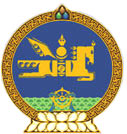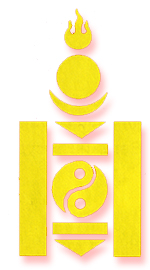The national emblem of Mongolia. Mongolia flag. Soyombo symbol.
TRIP TO MONGOLIA
INFORMATION FOR TRAVELERS
COAT OF ARMS OF MONGOLIA, STATE SYMBOL, FLAG

Mongolians have for centuries had a high respect for the symbols of state.
The national symbols of the Huns, one of the nation's ancestor tribes, were the
sun, moon and fire. The symbols of the empire founded by Chinggis Khaan were the
Nine White Banners (representing peace) and the Black Banner (representing
strength).
The symbol of the Bogd Khaan monarchy from 1911 was the soyombo, which in 1924,
at the first meeting of the Great Assembly (parliament), was adopted as
Mongolia's national emblem. The soyombo has a long tradition as a national
emblem, having been invented by Undur Gegeen Zanabazar, a descendant of Chinggis
Khaan and founder of Mongolian Lamaism. He claimed the emblem had mystical
meanings, and included the sun, moon and fire at the top.
The 1992 People's Assembly (Parliament) adopted a Constitution to include:
- the national emblem
- the flag
- the Nine White Banners
- the anthem
COAT OF ARMS OF MONGOLIA
 The
official coat of arms of Mongolia (Mongolian: Монгол улсын төрийн сүлд, Mongol
ulsyn töriin süld) was adopted in 1992 following the fall of the communist
government. The outer rim features a tumen nusan, symbolizing eternity,
surrounding a circular blue field, symbolizing the sky. On the centre of the
field is a combination of the Soyombo symbol and the wind horse (treasured
steed), symbolizing Mongolia's independence, sovereignty, and spirit. Above the
field is a chandmani, representing the Buddhist Three Jewels, which in Mongolian
folklore grants wishes, and symbolizes past, present, and future. Below the
central emblem is a green mountain range, with the wheel of destiny at the
center. On the bottom of the mountain range and wheel is a khadag, a ceremonial
scarf. The
official coat of arms of Mongolia (Mongolian: Монгол улсын төрийн сүлд, Mongol
ulsyn töriin süld) was adopted in 1992 following the fall of the communist
government. The outer rim features a tumen nusan, symbolizing eternity,
surrounding a circular blue field, symbolizing the sky. On the centre of the
field is a combination of the Soyombo symbol and the wind horse (treasured
steed), symbolizing Mongolia's independence, sovereignty, and spirit. Above the
field is a chandmani, representing the Buddhist Three Jewels, which in Mongolian
folklore grants wishes, and symbolizes past, present, and future. Below the
central emblem is a green mountain range, with the wheel of destiny at the
center. On the bottom of the mountain range and wheel is a khadag, a ceremonial
scarf.
 FLAG
OF MONGOLIA FLAG
OF MONGOLIA
The current flag of Mongolia was adopted on February 12, 1992. It is similar
to the flag of 1949, except for the removal of the socialist star. It has three
equal, vertical bands of red (hoist side), blue, and red. Centered on the
hoist-side red band in yellow is the national emblem (the Soyombo symbol - a
columnar arrangement of abstract and geometric representations of fire, sun,
moon, earth, water, and the Taijitu or Yin-Yang symbol).
 STATE
SYMBOL STATE
SYMBOL
The symbol of Bogd Khaan monarchy
from 1911 was the Soyombo, which was adopted as Mongolia's national emblem in
1924 at the first meeting of the Great Assembly (parliament). The Soyombo
has a long tradition as a national emblem, having been invented by Under Gegeen
Zanabazar, a descendant of Chinggis Khaan and founder of Mongolian Lamaism. The
People's Assembly held in 1992 adopted a Constitution to include: the national
emblem, the flag, the Nine White Banners and the anthem.
The biographies of Undurge-geen Zanabazar, who created the Mongolian alphabet in
1686, are significant because they contain the Soyombo alphabet, a symbol of
Mongolian independence and sovereignty and the state emblem.
Although the alphabet has not been adopted in general, many old manuscripts
written in Soyombo have been stored in the Erdene Zuu monastery, now a museum,
where there is a unique book on the history of the Soyombo alphabet, published
by Lama Dambadorj in 1799.
One excerpt from the treasured writings by Undurgegeen Zanabazar in Soyombo
script reads: "By the mercy of the heavens in the year of the Fiery Snow
Leopard, the last year of the eleventh sixty years, many ideas of the holy man
Zanabazar were realized. It was then that Bogd (one of the titles of the highest
lama) transferred his throne to the datsan (monastery) of
Ribogei-Gandan-Shadiblin from where he spread his spiritual power over the land
of the Blue Mongolians. In that year he cast his eternally famous statue of the
serene faced Goddess Tara. During the twelve days of the month of the Monkey,
Zanabazar completed his life's work, the Soyombo alphabet."
The Soyombo is a timeless and treasured combination of Mongolian historical and
cultural identities and wisdom:
- The three-pointed flame on the top of the Soyombo symbolizes the
flourishing of all people young and old, past, present and future.
- The representation of the sun and moon under the flame represents the
everlasting blue sky and indestructibility of Mongolia.
- The triangle under the flame, sun and moon, represents a sharp spearhead
to protect the nation from all enemies.
- The small shield-like rectangle on the Soyombo represents honesty,
stability and loyalty.
- The yin-yang circle encloses male and female fish. Mongolians believe
that fish never close their eyes and have many offspring, so this is a sign
to stay alert and have a big family.
- The two vertical oblongs on the side represent a wall. If Mongolians
remain in harmony with their motherland, they will be stronger than any iron
wall. The Soyombo exhorts Mongolians to flourish like a flame; to be as
bright as the sun and moon; as straight as an arrow; safe as Armour; alert
and plentiful as fish and as strong as an iron wall.
NATIONAL ANTHEM OF MONGOLIA
The National Anthem of Mongolia was created in 1950. The music is a composition
by Bilegiin Damdinsüren (1919 - 1991) and Luvsanyamts Murdorj (1915 - 1996), the
lyrics were written by Tsendiin Damdinsüren (1908 - 1988).
Over the twentieth century, Mongolia had several national anthems. The first one
was used between 1924 and 1950. The second between 1950 and 1962, and a third
one between 1961 and 1991. Since 1991, most of the anthem of 1950 is used again,
but the second verse (praising Lenin, Stalin, Sükhbaatar, and Choibalsan) has
been removed. On July 6th, 2006 the lyrics were revised by the Mongolian
Parliament to commemorate Genghis Khan.
English Translation
Our unwavering independent nation
All Mongols' sacred ancestry
All world's good deeds
Always stable, forever continue
With all honest nations of the world
Strengthen our bonds
With all our will and strength
Let's develop our beloved Mongolia
Our great nation's symbol blesses
The people's fate supports
Our ancestry, culture and language
Let's forever cherish and prosper
Bright peoples of brave Mongolia
Have freedom and happiness
Key to happiness, column for prosperity
Our great country prosper
PICTURES ALBUM
|